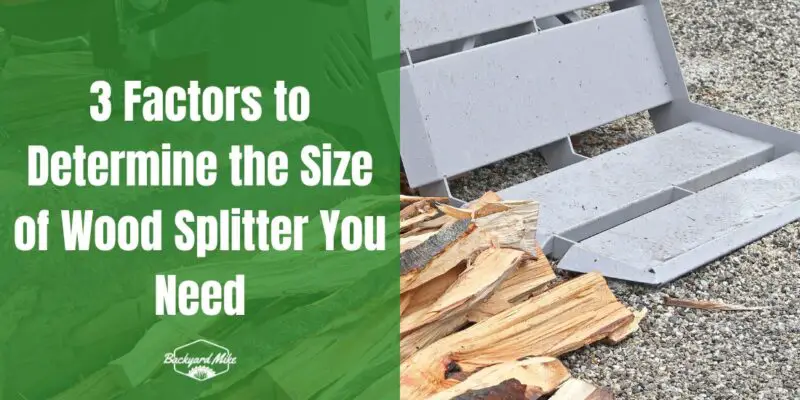When choosing a wood splitter, consider three key factors: wood hardness, log diameter, and splitter features. The Janka Scale helps you understand the wood's resistance; harder woods need more force. Measure the log's diameter to determine required tonnage; larger logs generally need over 20 tons. Finally, evaluate splitter features like cycle time and pressure output. With these factors, you'll make an informed choice for effective splitting. Discover more insights to guarantee a perfect match.
Key Takeaways
- Assess the diameter and length of logs to determine the required tonnage for effective splitting.
- Consider wood hardness using the Janka scale to choose a splitter with adequate power.
- Evaluate the splitter's cycle time for productivity based on the expected volume of wood processing.
- Balance mobility needs against noise preferences when choosing between gas-powered and electric splitters.
- Plan for maintenance and upkeep requirements to ensure long-term splitter performance and durability.
Understanding Wood Hardness and Species
When you're trying to understand wood hardness and species, start by considering the Janka Scale. This scale helps you classify woods by measuring their resistance to denting and wear. High Janka ratings indicate harder woods, which are usually more durable. For instance, Australian Buloke, with a Janka rating of 5,060 lbf, is one of the hardest woods. In contrast, softwoods like Eastern White Pine have lower ratings, around 380 lbf. The Janka value is crucial in determining the type of wood suitable for various applications, ensuring that the chosen wood meets the necessary durability requirements. Understanding these wood classifications is essential when selecting materials for projects. Hardwoods like oak and maple, with Janka ratings between 1,000 to 1,450 lbf, are popular for furniture due to their durability.
Assessing Log Size and Diameter
Although selecting the right wood splitter may seem intimidating, analyzing log size and diameter is a critical first step.
Begin by using log measurement techniques to determine the average diameter, measuring from the center of each log. This measurement directly impacts the tonnage required.
For example, logs less than 12 inches in diameter typically need 4-7 tons of force, while medium-sized logs (12-24 inches) require 8-20 tons.
Larger or tougher logs, 24 inches and above, demand at least 20 tons for effective splitting. Understanding the log thickness impact helps you choose a splitter that aligns with your needs. Additionally, it is important to evaluate the log lengths to ensure the splitter's capabilities match the size of the logs you intend to split.
Evaluating Log Splitter Performance and Features
After evaluating log size and diameter, it's important to take into account the performance and features of a log splitter to guarantee it meets your needs. Consider the cycle time, which is essential for productivity. Kinetic splitters offer faster cycle times, making them ideal if you need quick results. Pressure output is another key factor; hydraulic models typically provide between 2500 and 3000 psi, ensuring efficient splitting for tougher wood. The Boss Industrial ES7T20 Electric Log Splitter is a budget-friendly option that provides a 7-ton capacity, making it suitable for various log sizes and types. Evaluate the power source and type—gas-powered splitters offer mobility and high performance, whereas electric models are quieter and suitable for indoor use. Maintenance needs also differ; kinetic splitters usually require less upkeep. Log width and hardness determine the necessary tonnage rating, so it's crucial to select a splitter capable of handling the hardest logs you expect to manage.
Frequently Asked Questions
How Does Climate Affect Wood Splitting Needs?
In cold climates, you're facing denser wood, which makes splitting tougher. Embrace the challenge with a powerful splitter, and you'll feel part of a community that respects nature's rhythms and adapts to its demands.
Are There Environmental Considerations When Choosing a Log Splitter?
When choosing a log splitter, consider sustainable practices and noise pollution. Electric models emit no fumes and are quieter, fostering a community that values green choices. You'll make a difference while connecting with like-minded individuals.
What Is the Cost Range for Different Log Splitters?
You're looking at a range from a few hundred dollars for electric splitters to several thousand for hydraulic splitters. Choosing the right one connects you with a community of DIY enthusiasts who appreciate power and efficiency.
How Does Splitter Fuel Type Influence Performance?
You'll find gas vs diesel models offer more raw power for heavy-duty tasks, but electric efficiency suits lighter jobs with eco-friendly appeal. Choosing the right fuel type enhances your performance and connects you with the right community.
Are There Warranties Commonly Offered With Log Splitters?
Imagine a trusty shield protecting your cherished log splitter. Warranties provide that shield, offering warranty coverage for peace of mind. But remember, maintenance options are essential; neglect them, and your shield might crumble, leaving you unprotected.
Conclusion
When choosing a wood splitter, consider the hardness of the wood species, the log size, and the splitter's performance. Curiously, a splitter with 20 tons of force can handle most residential needs, splitting logs up to 24 inches in diameter. Understand these factors to make an informed decision. Remember, matching the splitter to your specific requirements guarantees efficiency and safety. By evaluating these elements, you'll select a tool that's both powerful and suitable for your tasks.


